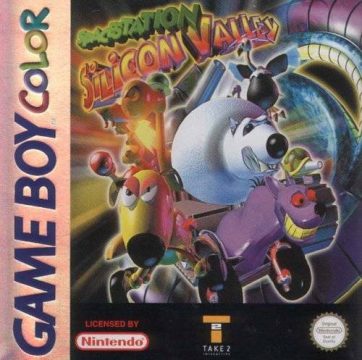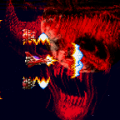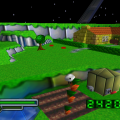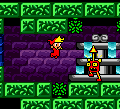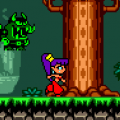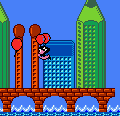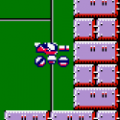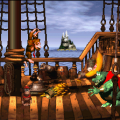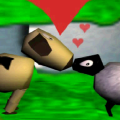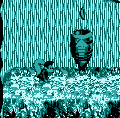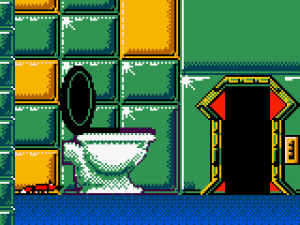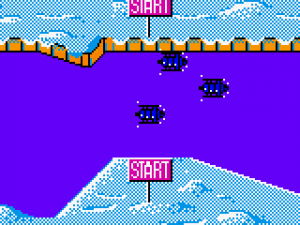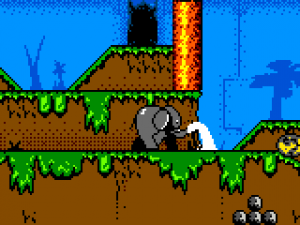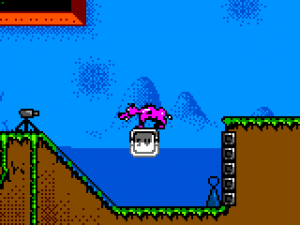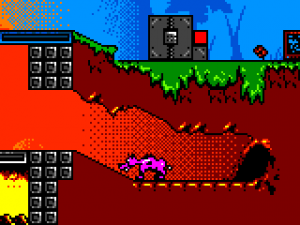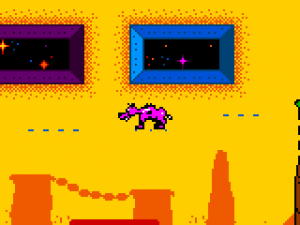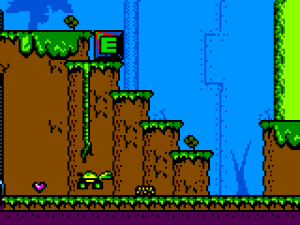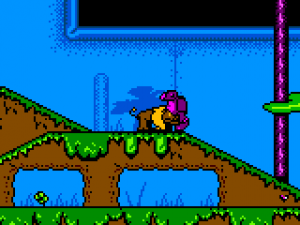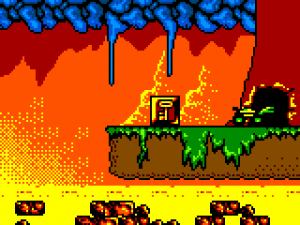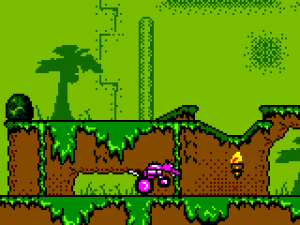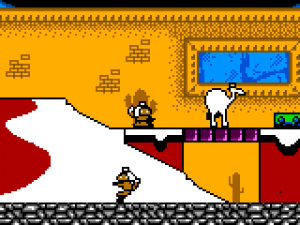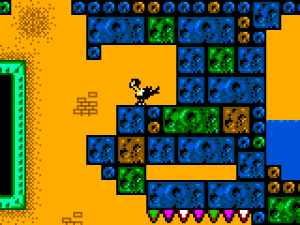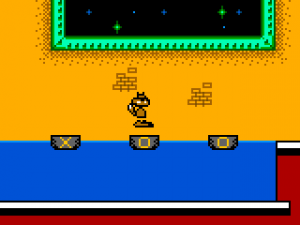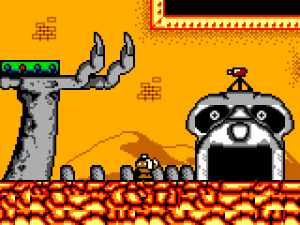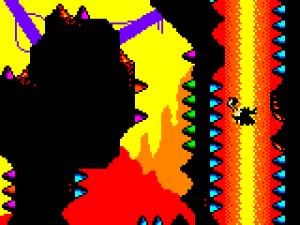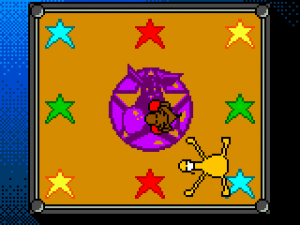- SpaceStation Silicon Valley
- SpaceStation Silicon Valley (Game Boy Color)
- Evo’s Space Adventures
Unlike the subsequent wretched PlayStation port, this is an extremely faithful reiteration of the N64 original, and it’s not even in 3D! Developed by Tarantula Studios, which would later be absorbed into the enormous Rockstar Games portfolio of developers, SpaceStation Silicon Valley on GBC is a fantastic retro-styled remake of the original, or rather “demake”. In fact it’s so faithful, so expertly crafted in its adherence to the original, that it stands as a textbook example of how to convert an ambitious game from a powerful platform to a much weaker one.
All 32 levels from the original are present; none are cut, and the level names, descriptions and most of the mission objectives are also identical. The majority of animals are also present, with only a few being replaced – the spitting camel from the desert zone is now the same as the camel with a cannon on his back. Some objectives are altered, but overall Tarantula converted the entire experience into what is basically a high-end NES game. The level design and structure is so perfectly suited to the 2D perspective though, that if someone didn’t know which came first, you might be able to trick them into thinking the N64 release was an upscale remake. Take Battery Farm: you still need to grow carrots to jump up to a higher level, while the barn with the dog to be crushed is accessed via a door in the background. Everything is the same, albeit in 2D. Occasionally something is altered, for example on Jungle Bungle, where the log-ride objective is removed. You still need the hippo to activate an underwater switch, but it raises a platform, instead of setting off the Frogger-style mini-game. So similar are the two games, that it’s difficult to quantify the enjoyment of playing the GBC release, because if you’re a veteran of the N64 original, much of its charm comes from recognising specific puzzles and how they’ve been converted.
The designers at Tarantula Studios were obviously big fans of the original, or were under strict orders to make it identical. They deserve tremendous praise for the painstaking attention to detail which clearly went into recreating almost every element from the N64 release, pixel by pixel. Given the team’s obvious talent, it’s surprising they didn’t make a full-blown sequel. In a way, it’s almost a wasted opportunity. SSSV on GBC is both identical and wholly different to its predecessor; thematically alike, though structurally redefined. The team did, however, add some original ideas into the mix. There’s some ingenious twists with regards to the souvenirs, which now have their own bespoke solutions. Take Penguin Playpen, for example. In the original you had to kill all the fish to make the souvenir appear. On the GBC, however, it’s a little more fiendish. You need to take the seagull from the second room to the first, pick up the stone near the pile, fly to the far right, and precisely drop it on the moving fish below. Once this fish is dead you land on the water, evacuate Evo from the seagull body and then – as he’s falling to his death in the bottomless pit – hit select button to warp into the fish body. Next you body flop out of the water and up the slope, then slide across an invisible bridge towards the souvenir (pictured below). Take too long though and the fish dies from lack of water. It’s a top class puzzle with an amazing eureka moment. Imagine how amazing the whole game would have been if developed from scratch as a sequel.
For all the praise regarding how close this “demake” is, the team did paint themselves into corners sometimes. Take the Swamp of Eternal Stench level: in the original you find the Death Slide, which is basically a floating vine that carries you around the 3D level, collecting energy balls. On GBC you can’t really do this, so the vine is right next to the exit and touching it activates the teleporter. The mission objectives are recreated almost verbatim, but in doing so this one becomes a bit redundant. Additionally, there are now several opportunities to get stuck, one of the worst examples being the second level. On the N64, if you killed a sheep outside the sheep pen you could possess it, place it inside the pen, then eject from the body and return to the dog. On GBC, if you kill a sheep outside the pen there’s no way to get it inside, so you need to reset the stage. Actually, the whole second level sucks, and could put less persistent players off. In transferring the landscape to a 2D environment there are now hills, and stray sheep choose to go up or down them entirely randomly, meaning when the dog is chasing them into the pen it could be 20 attempts before the sheep randomly decides to go up the hill towards the pen, rather down towards the water.
Another place you can get permanently stuck is Penguin Playpen, where if you fall in the water you can’t climb out. In this regard the designers let themselves down, because on the N64 it was almost impossible to get permanently stuck. As an open-world, sandbox style game, the job of the designer is to put checks in place to make sure the player can’t accidentally lock himself out. On the N64 this rarely happened. One instance was Craig’s Stump, where you could get the gorilla permanently stuck on the other side of the river, but you really had to work at breaking the game’s physics in order to put yourself in this position (it involved some glitched jumping and carrying a crate to where it shouldn’t be). On GBC it’s much easier to get stuck through no fault of your own, and not in a game over situation, but rather one where you have to manually restart.
Another oversight is that you can’t access later zones, like you could in the N64 release. The game is fairly easy, and the levels short, so it was likely an intentional design decision, but it’s still unfortunate. By forcing you to complete all the themed levels in order you tend to be sick of them by the end of the zone, whereas on the N64 you could flit between European, Ice, Jungle and Desert as you pleased, like some kind of buffet.
It’s difficult to say more about the GBC release without repeating what was said about the original – if you play through both games in their entirety, it’s obvious how almost identical they are. If you’re going to play only one, it should be the N64 original, since it’s an amazing achievement and an astounding experience, featuring some of the most intelligent game design you will find. But if you’re a keen handheld aficionado, then this is a fascinating portable alternative (persevere past level 2, since it rapidly improves). Quick saving should also help with some of the sticking points. The game was only released in Europe, so good luck finding an original cartridge!

